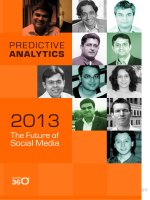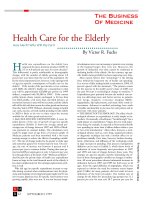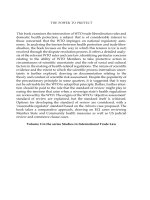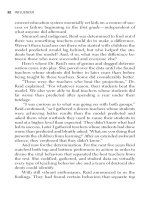Predictive analytics the power to predict who will click, buy, lie, or die eric siegel
Bạn đang xem bản rút gọn của tài liệu. Xem và tải ngay bản đầy đủ của tài liệu tại đây (4.94 MB, 379 trang )
Praise for Predictive Analytics
“The Freakonomics of big data.”
—Stein Kretsinger, founding executive of Advertising.com; former lead analyst at Capital One
“A clear and compelling explanation of the power of predictive analytics, and how it can transform
companies and even industries.”
—Anthony Goldbloom, founder and CEO, Kaggle.com
“The definitive book of this industry has arrived. Dr. Siegel has achieved what few have even
attempted: an accessible, captivating tome on predictive analytics that is a must read for all
interested in its potential—and peril.”
—Mark Berry, VP, People Insights, ConAgra Foods
“A fascinating page-turner about the most important new form of information technology.”
—Emiliano Pasqualetti, CEO, DomainBot Inc.
“As our ability to collect and analyze information improves, experts like Eric Siegel are our guides
to the mysteries unlocked and the moral questions that arise.”
—Jules Polonetsky, Co-Chair and Director, Future of Privacy Forum; former Chief Privacy Officer,
AOL and DoubleClick
“In a fascinating series of examples, Siegel shows how companies have made money predicting
what customers will do. Once you start reading, you will not be able to put it down.”
—Arthur Middleton Hughes, VP, Database Marketing Institute; author of Strategic Database
Marketing, Fourth Edition
“Excellent. Each chapter makes the complex comprehensible, making heavy use of graphics to give
depth and clarity. It gets you thinking about what else might be done with predictive analytics.”
—Edward Nazarko, Client Technical Advisor, IBM
“I’ve always been a passionate data geek, but I never thought it might be possible to convey the
excitement of data mining to a lay audience. That is what Eric Siegel does in this book. The stories
range from inspiring to downright scary—read them and find out what we’ve been up to while you
weren’t paying attention.”
—Michael J. A. Berry, author of Data Mining Techniques, Third Edition
“Eric Siegel is the Kevin Bacon of the predictive analytics world, organizing conferences where
insiders trade knowledge and share recipes. Now, he has thrown the doors open for you. Step in
and explore how data scientists are rewriting the rules of business.”
—Kaiser Fung, VP, Vimeo; author of Numbers Rule Your World
“Written in a lively language, full of great quotes, real-world examples, and case studies, it is a
pleasure to read. The more technical audience will enjoy chapters on The Ensemble Effect and
uplift modeling—both very hot trends. I highly recommend this book!”
—Gregory Piatetsky-Shapiro, Editor, KDnuggets; founder, KDD Conferences
“Highly recommended. As Siegel shows in his very readable new book, the results achieved by
those adopting predictive analytics to improve decision making are game changing.”
—James Taylor, CEO, Decision Management Solutions
“What is predictive analytics? This book gives a practical and up-to-date answer, adding new
dimension to the topic and serving as an excellent reference.”
—Ramendra K. Sahoo, Senior VP, Risk Management and Analytics, Citibank
“Exciting and engaging—reads like a thriller! Predictive analytics has its roots in people’s daily
activities, and, if successful, affects people’s actions. By way of examples, Siegel describes both
the opportunities and the threats predictive analytics brings to the real world.”
—Marianna Dizik, Statistician, Google
“Competing on information is no longer a luxury—it’s a matter of survival. Despite its successes,
predictive analytics has penetrated only so far, relative to its potential. As a result, lessons and
case studies such as those provided in Siegel’s book are in great demand.”
—Boris Evelson, VP and Principal Analyst, Forrester Research
“Fascinating and beautifully conveyed. Siegel is a leading thought leader in the space—a must-
have for your bookshelf!”
—Sameer Chopra, VP, Advanced Analytics, Orbitz Worldwide
“A brilliant overview—strongly recommended to everyone curious about the analytics field and its
impact on our modern lives.”
—Kerem Tomak, VP of Marketing Analytics, Macys.com
“Eric explains the science behind predictive analytics, covering both the advantages and the
limitations of prediction. A must read for everyone!”
—Azhar Iqbal, VP and Econometrician, Wells Fargo Securities, LLC
“Predictive Analytics delivers a ton of great examples across business sectors of how companies
extract actionable, impactful insights from data. Both the novice and the expert will find interest
and learn something new.”
—Chris Pouliot, Director, Algorithms and Analytics, Netflix
“In this new world of big data, machine learning, and data scientists, Eric Siegel brings deep
understanding to deep analytics.”
—Marc Parrish, VP, Membership, Barnes & Noble
“A detailed outline for how we might tame the world’s unpredictability. Eric advocates quite
clearly how some choices are predictably more profitable than others—and I agree!”
—Dennis R. Mortensen, CEO of Visual Revenue, former Director of Data Insights at Yahoo!
“This book is an invaluable contribution to predictive analytics. Eric’s explanation of how to
anticipate future events is thought provoking and a great read for everyone.”
—Jean Paul Isson, Global VP Business Intelligence and Predictive Analytics, Monster Worldwide;
coauthor, Win with Advanced Business Analytics: Creating Business Value from Your Data
“Eric Siegel’s book succeeds where others have failed—by demystifying big data and providing
real-world examples of how organizations are leveraging the power of predictive analytics to
drive measurable change.”
—Jon Francis, Senior Data Scientist, Nike
“Predictive analytics is the key to unlocking new value at a previously unimaginable economic
scale. In this book, Siegel explains how, doing an excellent job to bridge theory and practice.”
—Sergo Grigalashvili, VP of Information Technology, Crawford & Company
“Predictive analytics has been steeped in fear of the unknown. Eric Siegel distinctively clarifies,
removing the mystery and exposing its many benefits.”
—Jane Kuberski, Engineering and Analytics, Nationwide Insurance
“As predictive analytics moves from fashionable to mainstream, Siegel removes the complexity
and shows its power.”
—Rajeeve Kaul, Senior VP, OfficeMax
“Dr. Siegel humanizes predictive analytics. He blends analytical rigor with real-life examples with
an ease that is remarkable in his field. The book is informative, fun, and easy to understand. I
finished reading it in one sitting. A must read . . . not just for data scientists!”
—Madhu Iyer, Marketing Statistician, Intuit
“An engaging encyclopedia filled with real-world applications that should motivate anyone still
sitting on the sidelines to jump into predictive analytics with both feet.”
—Jared Waxman, Web Marketer at LegalZoom, previously at Adobe, Amazon, and Intuit
“Siegel covers predictive analytics from start to finish, bringing it to life and leaving you wanting
more.”
—Brian Seeley, Manager, Risk Analytics, Paychex, Inc.
“A wonderful look into the world of predictive analytics from the perspective of a true
practitioner.”
—Shawn Hushman, VP, Analytic Insights, Kelley Blue Book
“An excellent exposition on the next generation of business intelligence—it’s really mankind’s
latest quest for artificial intelligence.”
—Christopher Hornick, President and CEO, HBSC Strategic Services
“A must—Predictive Analytics provides an amazing view of the analytical models that predict and
influence our lives on a daily basis. Siegel makes it a breeze to understand, for all readers.”
—Zhou Yu, Online-to-Store Analyst, Google
“[Predictive Analytics is] an engaging, humorous introduction to the world of the data scientist. Dr.
Siegel demonstrates with many real-life examples how predictive analytics makes big data
valuable.”
—David McMichael, VP, Advanced Business Analytics
Cover design: Paul McCarthy
Interior image design: Matt Kornhaas
Copyright © 2013 by Eric Siegel. All rights reserved.
Published by John Wiley & Sons, Inc., Hoboken, New Jersey.
Published simultaneously in Canada.
Jeopardy!® is a registered trademark of Jeopardy Productions, Inc.
No part of this publication may be reproduced, stored in a retrieval system, or transmitted in any form
or by any means, electronic, mechanical, photocopying, recording, scanning, or otherwise, except as
permitted under Section 107 or 108 of the 1976 United States Copyright Act, without either the prior
written permission of the Publisher, or authorization through payment of the appropriate per-copy fee
to the Copyright Clearance Center, 222 Rosewood Drive, Danvers, MA 01923, (978) 750-8400, fax
(978) 646-8600, or on the web at www.copyright.com. Requests to the Publisher for permission
should be addressed to the Permissions Department, John Wiley & Sons, Inc., 111 River Street,
Hoboken, NJ 07030, (201) 748-6011, fax (201) 748-6008, or online at
www.wiley.com/go/permissions.
Limit of Liability/Disclaimer of Warranty: While the publisher and author have used their best efforts
in preparing this book, they make no representations or warranties with the respect to the accuracy or
completeness of the contents of this book and specifically disclaim any implied warranties of
merchantability or fitness for a particular purpose. No warranty may be created or extended by sales
representatives or written sales materials. The advice and strategies contained herein may not be
suitable for your situation. You should consult with a professional where appropriate. Neither the
publisher nor the author shall be liable for damages arising herefrom.
For general information about our other products and services, please contact our Customer Care
Department within the United States at (800) 762-2974, outside the United States at (317) 572-3993
or fax (317) 572-4002.
Wiley publishes in a variety of print and electronic formats and by print-on-demand. Some material
included with standard print versions of this book may not be included in e-books or in print-on-
demand. If this book refers to media such as a CD or DVD that is not included in the version you
purchased, you may download this material at . For more information
about Wiley products, visit www.wiley.com.
Library of Congress Cataloging-in-Publication Data:
Siegel, Eric.
Predictive analytics : the power to predict who will click, buy, lie, or die / Eric Siegel.
p. cm.
Includes index.
ISBN 978-1-118-35685-2 (cloth); ISBN 978-1-118-42062-1 (ebk); ISBN 978-1-118-41685-3 (ebk);
ISBN 978-1-118-59647-0 (ebk)
1. Social sciences—Forecasting. 2. Economic forecasting 3. Prediction (Psychology) 4. Social
prediction. 5. Human behavior. I. Title.
H61.4.S54 2013
303.49—dc23
2012047252
This book is dedicated with all my heart to my mother, Lisa Schamberg,
and my father, Andrew Siegel.
Contents
Foreword
Preface
Introduction
Chapter 1: Liftoff! Prediction Takes Action (deployment)
Going Live
A Faulty Oracle Everyone Loves
Predictive Protection
A Silent Revolution Worth a Million
The Perils of Personalization
Deployment’s Detours and Delays
In Flight
Elementary, My Dear: The Power of Observation
To Act Is to Decide
A Perilous Launch
Houston, We Have a Problem
The Little Model That Could
Houston, We Have Liftoff
A Passionate Scientist
Launching Prediction into Inner Space
Chapter 2: With Power Comes Responsibility (ethics)
The Prediction of Target and the Target of Prediction
A Pregnant Pause
My 15 Minutes
Thrust into the Limelight
You Can’t Imprison Something That Can Teleport
Law and Order: Policies, Politics, and Policing
The Battle over Data
Data Mining Does Not Drill Down
HP Learns about Itself
Insight or Intrusion?
Flight Risk: I Quit!
Insights: The Factors behind Quitting
Delivering Dynamite
Don’t Quit While You’re Ahead
Predicting Crime to Stop It Before It Happens
The Data of Crime and the Crime of Data
Machine Risk without Measure
The Cyclicity of Prejudice
Good Prediction, Bad Prediction
The Source of Power
Chapter 3: The Data Effect (data)
The Data of Feelings and the Feelings of Data
Predicting the Mood of Blog Posts
The Anxiety Index
Visualizing a Moody World
Put Your Money Where Your Mouth Is
Inspiration and Perspiration
Sifting Through the Data Dump
The Instrumentation of Everything We Do
Batten Down the Hatches: T.M.I.
The Big Bad Wolf
The End of the Rainbow
Prediction Juice
Far Out, Bizarre, and Surprising Insights
Correlation Does Not Imply Causation
The Cause and Effect of Emotions
A Picture Is Worth a Thousand Diamonds
Validating Feelings and Feeling Validated
Serendipity and Innovation
Investment Advice from the Blogosphere
Money Makes the World Go ‘Round
Putting It All Together
Chapter 4: The Machine That Learns (modeling)
Boy Meets Bank
Bank Faces Risk
Prediction Battles Risk
Risky Business
The Learning Machine
Building the Learning Machine
Learning from Bad Experiences
How Machine Learning Works
Decision Trees Grow on You
Computer, Program Thyself
Learn Baby Learn
Bigger Is Better
Overlearning: Assuming Too Much
The Conundrum of Induction
The Art and Science of Machine Learning
Feeling Validated: Test Data
Carving Out a Work of Art
Putting Decision Trees to Work for Chase
Money Grows on Trees
The Recession—Why Microscopes Can’t Detect Asteroid Collisions
After Math
Chapter 5: The Ensemble Effect (ensembles)
Casual Rocket Scientists
Dark Horses
Mindsourced: Wealth in Diversity
Crowdsourcing Gone Wild
Your Adversary Is Your Amigo
United Nations
Meta-Learning
A Big Fish at the Big Finish
Collective Intelligence
The Wisdom of Crowds . . . of Models
A Bag of Models
Ensemble Models in Action
The Generalization Paradox: More Is Less
The Sky’s the Limit
Chapter 6: Watson and the Jeopardy! Challenge (question answering)
Text Analytics
Our Mother Tongue’s Trials and Tribulations
Once You Understand the Question, Answer It
The Ultimate Knowledge Source
Artificial Impossibility
Learning to Answer Questions
Walk Like a Man, Talk Like a Man
A Better Mousetrap
The Answering Machine
Moneyballing Jeopardy!
Amassing Evidence for an Answer
Elementary, My Dear Watson
Mounting Evidence
Weighing Evidence with Ensemble Models
An Ensemble of Ensembles
Machine Learning Achieves the Potential of Language Processing
Confidence without Overconfidence
The Need for Speed
Double Jeopardy!—Would Watson Win?
Jeopardy! Jitters
For the Win
After Match: Honor, Accolades, and Awe
Iambic IBM AI
Predict the Right Thing
Chapter 7: Persuasion by the Numbers (uplift)
Churn Baby Churn
Sleeping Dogs
A New Thing to Predict
Eye Can’t See It
Perceiving Persuasion
Persuasive Choices
Business Stimulus and Business Response
The Quantum Human
Predicting Influence with Uplift Modeling
Banking on Influence
Predicting the Wrong Thing
Response Uplift Modeling
The Mechanics of Uplift Modeling
How Uplift Modeling Works
The Persuasion Effect
Influence Across Industries
Immobilizing Mobile Customers
Afterword: Ten Predictions for the First Hour of 2020
Appendices
Appendix A. Five Effects of Prediction
Appendix B. Twenty-One Applications of Predictive Analytics
Appendix C. Prediction People—Cast of “Characters”
Notes
Acknowledgments
About the Author
Supplement: A Cross-Industry Compendium of 147 Examples
Index
Foreword
This book deals with quantitative efforts to predict human behavior. One of the earliest efforts to do
that was in World War II. Norbert Wiener, the father of “cybernetics,” began trying to predict the
behavior of German airplane pilots in 1940—with the goal of shooting them from the sky. His method
was to take as input the trajectory of the plane from its observed motion, consider the pilot’s most
likely evasive maneuvers, and predict where the plane would be in the near future so that a fired shell
could hit it. Unfortunately, Wiener could predict only one second ahead of a plane’s motion, but 20
seconds of future trajectory were necessary to shoot down a plane.
In Eric Siegel’s book, however, you will learn about a large number of prediction efforts that are
much more successful. Computers have gotten a lot faster since Wiener’s day, and we have a lot more
data. As a result, banks, retailers, political campaigns, doctors and hospitals, and many more
organizations have been quite successful of late at predicting the behavior of particular humans. Their
efforts have been helpful at winning customers, elections, and battles with disease.
My view—and Siegel’s, I would guess—is that this predictive activity has generally been good for
humankind. In the context of healthcare, crime, and terrorism, it can save lives. In the context of
advertising, using predictions is more efficient, and could conceivably save both trees (for direct
mail and catalogs) and the time and attention of the recipient. In politics, it seems to reward those
candidates who respect the scientific method (some might disagree, but I see that as a positive).
However, as Siegel points out—early in the book, which is admirable—these approaches can also
be used in somewhat harmful ways. “With great power comes great responsibility,” he notes in
quoting Spider-Man. The implication is that we must be careful as a society about how we use
predictive models, or we may be restricted from using and benefiting from them. Like other powerful
technologies or disruptive human innovations, predictive analytics is essentially amoral, and can be
used for good or evil. To avoid the evil applications, however, it is certainly important to understand
what is possible with predictive analytics, and you will certainly learn that if you keep reading.
This book is focused on predictive analytics, which is not the only type of analytics, but the most
interesting and important type. I don’t think we need more books anyway on purely descriptive
analytics, which only describe the past, and don’t provide any insight as to why it happened. I also
often refer in my own writing to a third type of analytics—“prescriptive”—that tells its users what to
do through controlled experiments or optimization. Those quantitative methods are much less popular,
however, than predictive analytics.
This book and the ideas behind it are a good counterpoint to the work of Nassim Nicholas Taleb.
His books, including The Black Swan, suggest that many efforts at prediction are doomed to fail
because of randomness and the inherent unpredictability of complex events. Taleb is no doubt correct
that some events are black swans that are beyond prediction, but the fact is that most human behavior
is quite regular and predictable. The many examples that Siegel provides of successful prediction
remind us that most swans are white.
Siegel also resists the blandishments of the “big data” movement. Certainly some of the examples
he mentions fall into this category—data that is too large or unstructured to be easily managed by
conventional relational databases. But the point of predictive analytics is not the relative size or
unruliness of your data, but what you do with it. I have found that “big data often equals small math,”
and many big data practitioners are content just to use their data to create some appealing visual
analytics. That’s not nearly as valuable as creating a predictive model.
Siegel has fashioned a book that is both sophisticated and fully accessible to the non-quantitative
reader. It’s got great stories, great illustrations, and an entertaining tone. Such non-quants should
definitely read this book, because there is little doubt that their behavior will be analyzed and
predicted throughout their lives. It’s also quite likely that most non-quants will increasingly have to
consider, evaluate, and act on predictive models at work.
In short, we live in a predictive society. The best way to prosper in it is to understand the
objectives, techniques, and limits of predictive models. And the best way to do that is simply to keep
reading this book.
—Thomas H. Davenport
Thomas H. Davenport is a Visiting Professor at Harvard Business School, the President’s
Distinguished Professor at Babson College, cofounder of the International Institute for Analytics, and
coauthor of Competing on Analytics and several other books on analytics.
Preface
Yesterday is history, tomorrow is a mystery, but today is a gift. That’s why we call it the
present.
—Attributed to A. A. Milne, Bill Keane, and Oogway, the wise turtle in Kung Fu Panda
People look at me funny when I tell them what I do. It’s an occupational hazard.
The Information Age suffers from a glaring omission. This claim may surprise many, considering
we are actively recording Everything That Happens in the World. Moving beyond history books that
document important events, we’ve progressed to systems that log every click, payment, call, crash,
crime, and illness. With this in place, you would expect lovers of data to be satisfied, if not spoiled
rotten.
But this apparent infinity of information excludes the very events that would be most valuable to
know of: things that haven’t happened yet.
Everyone craves the power to see the future; we are collectively obsessed with prediction. We
bow to prognostic deities. We empty our pockets for palm readers. We hearken to horoscopes, adore
astrology, and feast upon fortune cookies.
But many people who salivate for psychics also spurn science. Their innate response says “yuck”—
it’s either too hard to understand or too boring. Or perhaps many believe prediction by its nature is
just impossible without supernatural support.
There’s a lighthearted TV show I like premised on this very theme, Psych, in which a sharp-eyed
detective—a modern-day, data-driven Sherlock Holmesian hipster—has perfected the art of
observation so masterfully, the cops believe his spot-on deductions must be an admission of guilt.
The hero gets out of this pickle by conforming to the norm: he simply informs the police he is psychic,
thereby managing to stay out of prison and continuing to fight crime. Comedy ensues.
I’ve experienced the same impulse, for example, when receiving the occasional friendly inquiry as
to my astrological sign. But, instead of posing as a believer, I turn to humor: “I’m a Scorpio, and
Scorpios don’t believe in astrology.”
The more common cocktail party interview asks what I do for a living. I brace myself for eyes
glazing over as I carefully enunciate: predictive analytics. Most people have the luxury of describing
their job in a single word: doctor, lawyer, waiter, accountant, or actor. But, for me, describing this
largely unknown field hijacks the conversation every time. Any attempt to be succinct falls flat:
I’m a business consultant in technology. They aren’t satisfied and ask, “What kind of
technology?”
I make computers predict what people will do. Bewilderment results, accompanied by complete
disbelief and a little fear.
I make computers learn from data to predict individual human behavior . Bewilderment, plus
nobody wants to talk about data at a party.
I analyze data to find patterns. Eyes glaze over even more; awkward pauses sink amid a sea of
abstraction.
I help marketers target which customers will buy or cancel. They sort of get it, but this wildly
undersells and pigeonholes the field.
I predict customer behavior, like when Target famously predicted whether you are pregnant .
Moonwalking ensues.
So I wrote this book to demonstrate for you why predictive analytics is intuitive, powerful, and
awe-inspiring.
I have good news: a little prediction goes a long way. I call this The Prediction Effect, a theme
that runs throughout the book. The potency of prediction is pronounced—as long as the predictions
are better than guessing. This Effect renders predictive analytics believable. We don’t have to do the
impossible and attain true clairvoyance. The story is exciting yet credible: Putting odds on the future
to lift the fog just a bit off our hazy view of tomorrow means pay dirt. In this way, predictive analytics
combats financial risk, fortifies healthcare, conquers spam, toughens crime fighting, and boosts sales.
Do you have the heart of a scientist or a businessperson? Do you feel more excited by the very idea
of prediction, or by the value it holds for the world?
I was struck by the notion of knowing the unknowable. Prediction seems to defy a Law of Nature:
You cannot see the future because it isn’t here yet. We find a work-around by building machines that
learn from experience. It’s the regimented discipline of using what we do know—in the form of data
—to place increasingly accurate odds on what’s coming next. We blend the best of math and
technology, systematically tweaking until our scientific hearts are content to derive a system that
peers right through the previously impenetrable barrier between today and tomorrow.
Talk about boldly going where no one has gone before!
Some people are in sales; others are in politics. I’m in prediction, and it’s awesome.
The Prediction Effect
I’m just like you. I succeed at times, and at others I fail. Some days good things happen to me, some
days bad. We always wonder how things could have gone differently. I begin with six brief tales of
woe:
1. In 2009 I just about destroyed my right knee downhill skiing in Utah. The jump was no
problem; it was landing that presented an issue. For knee surgery, I had to pick a graft source
from which to reconstruct my busted ACL (the knee’s central ligament). The choice is a tough one
and can make the difference between living with a good knee or a bad knee. I went with my
hamstring. Could the hospital have selected a medically better option for my case?
2. Despite all my suffering, it was really my health insurance company that paid dearly—knee
surgery is expensive. Could the company have better anticipated the risk of accepting a ski
jumping fool as a customer and priced my insurance premium accordingly?
3. Back in 1995 another incident caused me suffering, although it hurt less. I fell victim to
identity theft, costing me dozens of hours of bureaucratic baloney and tedious paperwork to
clear up my damaged credit rating. Could the creditors have prevented the fiasco by detecting
that the accounts were bogus when they were filed under my name in the first place?
4. With my name cleared, I recently took out a mortgage to buy an apartment. Was it a good
move, or should my financial adviser have warned me the property could soon be outvalued by
my mortgage?
5. My professional life is susceptible, too. My business is faring well, but a company always
faces the risk of changing economic conditions and growing competition. Could we protect the
bottom line by foreseeing which marketing activities and other investments will pay off, and
which will amount to burnt capital?
6. Small ups and downs determine your fate and mine, every day. A precise spam filter has a
meaningful impact on almost every working hour. We depend heavily on effective Internet search
for work, health (e.g., exploring knee surgery options), home improvement, and most everything
else. We put our faith in personalized music and movie recommendations from Pandora and
Netflix. After all these years, my mailbox wonders why companies don’t know me well enough to
send less junk mail (and sacrifice fewer trees needlessly).
These predicaments matter. They can make or break your day, year, or life. But what do they all
have in common?
These challenges—and many others like them—are best addressed with prediction. Will the
patient’s outcome from surgery be positive? Will the credit applicant turn out to be a fraudster? Will
the homeowner face a bad mortgage? Will the customer respond if mailed a brochure? By predicting
these things, it is possible to fortify healthcare, decrease risk, conquer spam, toughen crime fighting,
and cut costs.
Prediction in Big Business—The Destiny of
Assets
There’s another angle. Beyond benefiting you and me as consumers, prediction serves the
organization, empowering it with an entirely new form of competitive armament. Corporations
positively pounce on prediction.
In the mid-1990s, an entrepreneurial scientist named Dan Steinberg marched into the nation’s
largest bank, Chase, to deliver prediction unto their management of millions of mortgages. This
mammoth enterprise put its faith in Dan’s predictive technology, deploying it to drive transactional
decisions across a tremendous mortgage portfolio. What did this guy have on his resume?
Prediction is power. Big business secures a killer competitive stronghold by predicting the future
destiny and value of individual assets. In this case, by driving mortgage decisions with predictions
about the future payment behavior of homeowners, Chase curtailed risk and boosted profit—the bank
witnessed a nine-digit windfall in one year.
Introducing . . . the Clairvoyant Computer
Compelled to grow and propelled to the mainstream, predictive technology is commonplace and
affects everyone, every day. It impacts your experiences in undetectable ways as you drive, shop,
study, vote, see the doctor, communicate, watch TV, earn, borrow, or even steal.
This book is about the most influential and valuable achievements of computerized prediction, and
the two things that make it possible: the people behind it, and the fascinating science that powers it.
Making such predictions poses a tough challenge. Each prediction depends on multiple factors: The
various characteristics known about each patient, each homeowner, and each e-mail that may be
spam. How shall we attack the intricate problem of putting all these pieces together for each
prediction?
The idea is simple, although that doesn’t make it easy. The challenge is tackled by a systematic,
scientific means to develop and continually improve prediction—to literally learn to predict.
The solution is machine learning—computers automatically developing new knowledge and
capabilities by furiously feeding on modern society’s greatest and most potent unnatural resource:
data.
“Feed Me!”—Food for Thought for the
Machine
Data is the new oil.
—European Consumer Commissioner Meglena Kuneva
The only source of knowledge is experience.
—Albert Einstein
In God we trust. All others must bring data.
—William Edwards Deming (a business professor famous for work in manufacturing)
Most people couldn’t be less interested in data. It can seem like such dry, boring stuff. It’s a vast,
endless regiment of recorded facts and figures, each alone as mundane as the most banal tweet, “I just
bought some new sneakers!” It’s the unsalted, flavorless residue deposited en masse as businesses
churn away.
Don’t be fooled! The truth is that data embodies a priceless collection of experience from which to
learn. Every medical procedure, credit application, Facebook post, movie recommendation,
fraudulent act, spammy e-mail, and purchase of any kind—each positive or negative outcome, each
successful or failed sales call, each incident, event, and transaction—is encoded as data and
warehoused. This glut grows by an estimated 2.5 quintillion bytes per day (that’s a 1 with 18 zeros
after it). And so a veritable Big Bang has set off, delivering an epic sea of raw materials, a plethora
of examples so great in number, only a computer could manage to learn from them. Used correctly,
computers avidly soak up this ocean like a sponge.
As data piles up, we have ourselves a genuine gold rush. But data isn’t the gold. I repeat, data in its
raw form is boring crud. The gold is what’s discovered therein.
The process of machines learning from data unleashes the power of this exploding resource. It
uncovers what drives people and the actions they take—what makes us tick and how the world
works. With the new knowledge gained, prediction is possible.
This learning process discovers insightful gems such as:
1
Early retirement decreases your life expectancy.
Online daters more consistently rated as attractive receive less interest.
Rihanna fans are mostly political Democrats.
Vegetarians miss fewer flights.
Local crime increases after public sporting events.
Machine learning builds upon insights such as these in order to develop predictive capabilities,
following a number-crunching, trial-and-error process that has its roots in statistics and computer
science.
I Knew You Were Going to Do That
With this power at hand, what do we want to predict? Every important thing a person does is
valuable to predict, namely: consume, think, work, quit, vote, love, procreate, divorce, mess up, lie,
cheat, steal, kill, and die. Let’s explore some examples.
2
People Consume
Hollywood studios predict the success of a screenplay if produced.
Netflix awarded $1 million to a team of scientists who best improved their recommendation system’s ability to predict
which movies you will like.
Australian energy company Energex predicts electricity demand in order to decide where to build out its power grid, and
Con Edison predicts system failure in the face of high levels of consumption.
Wall Street predicts stock prices by observing how demand drives them up and down. The firms AlphaGenius and
Derwent Capital drive hedge fund trading by following trends across the general public’s activities on Twitter.
Companies predict which customer will buy their products in order to target their marketing, from U.S. Bank down to
small companies like Harbor Sweets (candy) and Vermont Country Store (“top quality and hard-to-find classic
products”). These predictions dictate the allocations of precious marketing budgets. Some companies literally predict
how to best influence you to buy more (the topic of Chapter 7).
Prediction drives the coupons you get at the grocery cash register. UK grocery giant Tesco, the world’s third-largest
retailer, predicts which discounts will be redeemed in order to target more than 100 million personalized coupons
annually at cash registers across 13 countries. Prediction was shown to increase coupon redemption rates by a factor of
3.6 over previous methods. Similarly, Kmart, Kroger, Ralph’s, Safeway, Stop & Shop, Target, and Winn-Dixie follow in
kind.
Predicting mouse clicks pays off massively. Since websites are often paid per click for the advertisements they display,
they predict which ad you’re mostly likely to click in order to instantly choose which one to show you. This, in effect,
selects more relevant ads and drives millions in newly found revenue.
People Love, Work, Procreate, and Divorce
The leading career-focused social network, LinkedIn, predicts your job skills.
Online dating leaders Match.com, OkCupid, and eHarmony predict which hottie on your screen would be the best bet at
your side.
Target predicts customer pregnancy in order to market relevant products accordingly. Nothing foretells consumer need
like predicting the birth of a new consumer.
Clinical researchers predict infidelity and divorce. There’s even a self-help website tool to put odds on your marriage’s
long-term success (www.divorce360.com), and public rumors have suggested credit card companies do the same.
People Think and Decide
Obama was re-elected in 2012 with the help of voter prediction. The Obama for America Campaign predicted which
voters would be positively persuaded by campaign contact (a call, door knock, flier, or TV ad), and which would actually
be inadvertently influenced to vote adversely by contact. Employed to drive campaign decisions for millions of swing
state voters, this method was shown to successfully convince more voters to choose Obama than traditional campaign
targeting.
“What did you mean by that?” Systems have learned to ascertain the intent behind the written word. Citibank and
PayPal detect the customer sentiment about their products, and one researcher’s machine can tell which Amazon.com
book reviews are sarcastic.
Student essay grade prediction has been developed for possible use to automatically grade. The system grades as
accurately as human graders.
There’s a machine that can participate in the same capacity as humans in the United States’ most popular broadcast
celebration of human knowledge and cultural literacy. On the TV quiz show Jeopardy!, IBM’s Watson computer
triumphed. This machine learned to work proficiently enough with English to predict the answer to free-form inquiries
across an open range of topics and defeat the two all-time human champs.
Computers can literally read your mind. Researchers trained systems to decode a scan of your brain and determine
which type of object you’re thinking about—such as certain tools, buildings, and food—with over 80 percent accuracy
for some human subjects. In 2011, IBM predicted that mind-reading technology would be mainstream within five years.
People Quit
Hewlett-Packard (HP) earmarks each and every one of its more than 330,000 worldwide employees according to
“Flight Risk,” the expected chance he or she will quit their job so that managers may intervene in advance where
possible, and plan accordingly otherwise.
Ever experience frustration with your cell phone service? Your service provider endeavors to know. All major wireless
carriers predict how likely it is you will cancel and defect to a competitor—possibly before you have even conceived a
plan to do so—based on factors such as dropped calls, your phone usage, billing information, and whether your contacts
have already defected.
FedEx stays ahead of the game by predicting—with 65 to 90 percent accuracy—which customers are at risk of
defecting to a competitor.
The American Public University System predicted student dropouts and used these predictions to intervene
successfully; the University of Alabama, Arizona State University, Iowa State University, Oklahoma State University,
and the Netherlands’ Eindhoven University of Technology predict dropouts as well.
Wikipedia predicts which of its editors, who work for free as a labor of love to keep this priceless online asset alive, are
going to discontinue their valuable service.
Researchers at Harvard Medical School predict that if your friends stop smoking, you’re more likely to do so yourself as
well. Quitting smoking is contagious.
People Mess Up
Insurance companies predict who is going to crash a car or take a bad ski jump. Allstate predicts bodily injury liability
from car crashes based on the characteristics of the insured vehicle, demonstrating improvements to prediction that
could be worth an estimated $40 million annually. Another top insurance provider reported savings of almost $50 million
per year by expanding its actuarial practices with advanced predictive techniques.
Ford is learning from data so its cars can detect when the driver is not alert due to distraction, fatigue, or intoxication
and take action such as sounding an alarm.
Researchers have identified aviation incidents that are five times more likely than average to be fatal, using data from
the National Transportation Safety Board.
All large banks and credit card companies predict which debtors are most likely to turn delinquent, failing to pay back
their loans or credit card balances. Collection agencies prioritize their efforts with predictions of which tactic has the
best chance to recoup the most from each defaulting debtor.
People Get Sick and Die
I’m not afraid of death; I just don’t want to be there when it happens.
—Woody Allen
In 2013 the Heritage Provider Network is handing over $3 million to whichever competing team of scientists best
predicts individual hospital admissions. By following these predictions, proactive preventive measures can take a
healthier bite out of the tens of billions of dollars spent annually on unnecessary hospitalizations. Similarly, the University
of Pittsburgh Medical Center predicts short-term hospital readmissions, so doctors can be prompted to think twice
before a hasty discharge.
At Stanford University, a machine learned to diagnose breast cancer better than human doctors by discovering an
innovative method that considers a greater number of factors in a tissue sample.
Researchers at Brigham Young University and the University of Utah correctly predict about 80 percent of premature
births (and about 80 percent of full-term births), based on peptide biomarkers, as found in a blood exam as early as
week 24 of pregnancy.
University researchers derived a method to detect patient schizophrenia from transcripts of their spoken words alone.
A growing number of life insurance companies go beyond conventional actuarial tables and employ predictive
technology to establish mortality risk. It’s not called death insurance, but they calculate when you are going to die.
Beyond life insurance, one top-five health insurance company predicts the likelihood that elderly insurance policy holders
will pass away within 18 months, based on clinical markers in the insured’s recent medical claims. Fear not—it’s
actually done for benevolent purposes.
Researchers predict your risk of death in surgery based on aspects of you and your condition to help inform medical
decisions.
By following one common practice, doctors regularly—yet unintentionally—sacrifice some patients in order to save
others, and this is done completely without controversy. But this would be lessened by predicting something besides
diagnosis or outcome: healthcare impact (impact prediction is the topic of Chapter 7).









